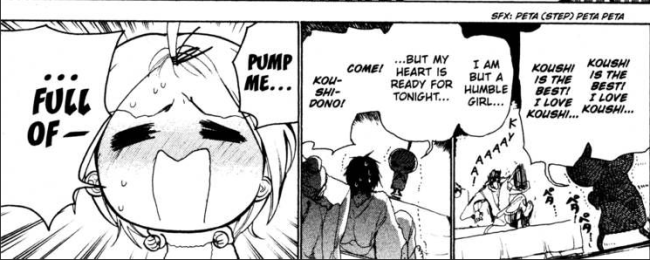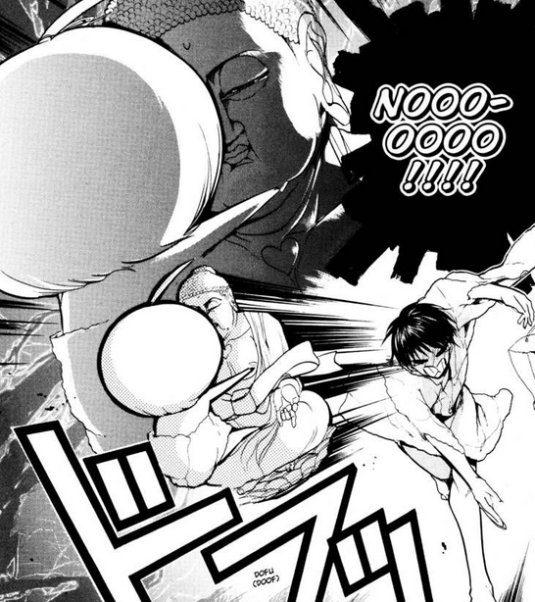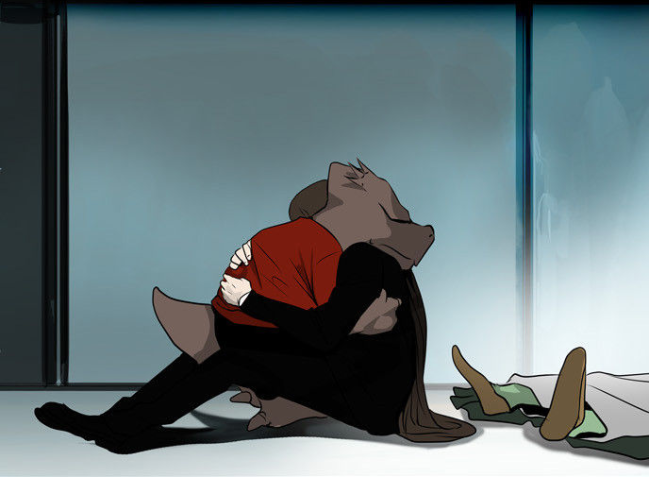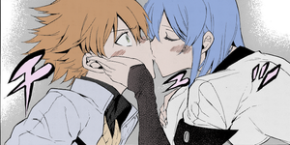Rave On, Tokyo!
Wait…Jon decided to review an anime? Sacrilege! For die-hard manga purists who want to know my rationale for beginning to review anime, please read the following three paragraphs. Otherwise, skip ahead for the actual review.
When I made this blog a year ago intending to review different manga/manhwa I read, I eventually decided to include Webtoons as well, beginning with Orange Marmalade. As of now, I’ve decided to expand my tastes to include anime reviews as well.
I was never a big anime fan to begin with, and truth be told I only ventured into the anime world when I noticed that some of the manga I had begun reading (Toradora, Golden Time, and Zetsuen no Tempest, just to name a few) and had grown fond of did not update for months. Of course, I couldn’t remain content to leave Ryuji and Taiga’s relationship hanging, so I went ahead and watched animated episodes from wherever the plot left off. Pretty soon, whenever I found a manga that was not finished translating, yet had an anime adaptation that had a palpable conclusion, I would just watch the anime. I noticed that especially in the case of manga that were adapted from light novels, the anime adaptations of the same light novel stories did a nice job of reaching some sort of conclusion without sacrificing too much of the plot and details of the storyline—all the while keeping me entertained.
Maybe it’s the summer, and therefore I feel like I have more time to allow myself to watch anime. At least when “free time” is scarce during the semester, I pretty much limit myself to reading manga, since pressing the right key every 5 or so seconds leads to faster plot progression in one hour, which, only amounts to about 3 episodes of anime. But hell, sometimes one simply cannot cram more shit about Th17 cells and vapor pressure into one’s brain, and anime provides a pretty good respite from constant mental energy expenditure.
In short—you don’t need any brain cells to enjoy anime (the fact is debatable for the enjoyment of manga/manhwa/webtoons, on the other hand). I’m sure baka-Tora would agree with me. Now let’s move onwards to my review for Tokyo Ravens; bear in mind that I am not evaluating the entire storyline/world that is presented in the light novels, which do contain some differences from the anime.
I stumbled upon the anime while trying to find something similar to the greatness of Shakugan no Shana (and Rie Kugimiya!), which is an anime that 1) is definitely worth watching despite it being three seasons long, each replete with 24 episodes and 2) I hope to review some time in the near future. But this isn’t a post that’s meant to compare the two anime; I firmly believe Tokyo Ravens—produced by 8bit, the same studio producers of Infinite Stratos—stands on its own two feet without recourse to simply a seemingly arbitrary comparison.
Storyline: Contrary to what other reviewers have said on MyAnimeList, I actually think TR starts out pretty strong with respect to plot and development. A pretty important character dies within the first three episodes, which sets the stage for protagonist Harutora Tsuchimikado’s introduction to the Onmyoji (or Shaman) world. But wait, you ask: how can a character be important if he/she dies in the first couple of episodes? Watch and see, dear readers—this is one of the beauties of this anime, that certain characters retain their importance (or whose importance is made more explicit as the plot progresses) without recourse to some deus ex machine that simply brings them back to life (though I won’t say that this does not occur in TR).
The world-building, in my opinion, has on one hand, the elements of any other shounen fantasy universe (and one that remains somewhat grounded in the “real world”), but then again, when the Tsuchimikado predecessor Yakou is mentioned in one episode as having participated in the “Pacific War,” there is some black and white camerareel footage of planes and ships from WWII, leading me to conclude that this fantasy-subuniverse-in-the-real-world does not attempt to distance itself from history, which is nice. Kind of like when we found out that the Cuban Missile Crisis was actually the result of a dispute between the young Charles Xavier and Eric Lehnsherr.
While the first half of the season mostly focuses on Harutora’s adjustment to life in the Shaman Academy and his relationships with the people there, which sounds very drab and banal to many anime connoisseurs, the second half of the season contains some pretty intricate plot unravelings and we find out who are the actual “bad guys.” But, like all good thought-provoking anime, the nature of these alliances is actually quite gray, and can perhaps be best-summarized as those wishing to take advantage of the reincarnation of the godlike Yakou Tsuchimikado and those who wish to prevent that from happening. Harutora and his friends lie somewhere in between—while embroiled ultimately in the conflict in the Shaman world, they still find it within themselves to not lose sight of what’s important: their personal bonds to one another as opposed to some old traditional quasi-familial ties.
Characters: Here I made a concession: there are certainly many stock characters modeled after ubiquitous anime archetypes, but hey, I didn’t find that to impede my ability to sympathize and empathize with many of them.
Yes, Harutora’s the zero-to-hero male protagonist that we see so often in Naruto, The Breaker, Zero no Tsukaima, Shakugan no Shana, etc. Yes, he’s also a familiar to the tsundere female lead, Natsume Tsuchimikado, which is why I can see why people would recommend TR to those who enjoyed the Saito and Louise dynamic of ZnT and the Yuji and Shana dynamic of SnS.
Harutora’s best friend, Eito Touji, is the archetypical cool, aloof sidekick/main supporting character (see “Sasuke Uchiha” and “Grey Fullbuster”) that stumbles down the wrong path at a certain point only to be brought back to the light by the male protagonist.
Then there’s the initial yandere Suzuka Dairenji and the busty, blonde Kyouko Kurahashi, both of whom we discover are in love with our boy hero. There’s also Tenma Momoe, your typical “weak” nerdy-looking pushover. And lastly, we can’t forget the cute fox-spirit Kon, who happens to be Harutora’s familiar. Those are probably some of the main supporting characters alongside Natsume and Harutora; guaranteed, if you enjoyed Shana’s array of classmates, you’ll find all their character doubles here in TR.
At least for me, what makes TR’s cast of characters—students and teachers, allies and enemies—endearing is that they are all intimately involved in the plot and progression of the story. And even if some of them aren’t involved in major battles, the anime, I believe, drops some important hints as to the role that Touji and Kyouko may play in (hopefully) the next season (…which will probably be released once there’s more material from the LNs to be worked with). Unlike Yuji’s classmates and family members in Shana, who ultimately forget about his existence (excluding Kazumi and Eiji) and therefore really do serve as extras in a comic-relief-providing “school-life” subplot, Natsume and Harutora’s interactions with their friends, their teachers (especially Ootomo Jin-sensei), and other members of the Shaman Bureau aren’t simply predetermined, static, and unimportant. Finally, TR does a good job with its villain portrayal; I really despise it when the antagonists are clearly portrayed as one-dimensional evil fiends and are therefore not meant to elicit any other emotion other than antipathy. For example, when Reiji Kagami, a Divine General and independent exorcist is introduced, you won’t immediately know whether this dude is “good” (I mean, he is working with the Shaman Agency to prevent spiritual disasters, right?) or “bad” (clearly he’s got a few screws loose if he’s willing to mow down students). At least in TR, sides aren’t clearly defined, and betrayal and clashes of personal ideals are quite rampant, which adds to the excitement. With time (from start to finish, this season spans roughly a year in the story, excluding flashbacks), characters change, and so do their ideals.
And did I forget to mention? There’s also romance.
Basically, what I’m trying to say is: 1) the characters are stock archetypes, but diverse and 2) they’re part of the reason why I like enjoyed the anime so much.
Visuals: Honestly, I was pretty impressed with the animation, both how the characters are portrayed as well as the CGI in the battle scenes. Maybe some people don’t like how some of the familiars look like shoddy second-hand gundams (or Transformers), but I think it fits considering the fact that hurt or damaged familiars undergo “lag” (and I suppose it brings back fond memories of Digimon). TR definitely has a plus on the animation here when compared to Shana or ZnT, and comes close to the epic visuals Kyoukai no Kanata.
Music: Nothing too much stands out here, except maybe the opening theme for the first 13 or so episodes: “X-encounter” by Maon Kurosaki. It’s pretty catchy, and I believe it fits well with the anime as a whole. Plus, the exorcist Kagami has a pretty catchy rock-and-roll leitmotiv associated with him, which always gets my adrenaline pumping whenever I hear it since you know at least with him, shit’s always gonna go down.
Overall Experience: Tokyo Ravens gave me exactly what I wanted: a solid, enjoyable 24-episode experience into the world of Japanese Shaman Society with excellent visuals, memorable scenes, a good plot, character development, and music that makes you want to download the opening song onto your iPod. I’m someone who enjoys watching anime shows, and movies that leave me questioning and reflecting on what I had just seen. The child tensai Natsume and the dim-witted Horatora, after all, are two characters with a seemingly powerful lineage who must come to terms with who they are, respectively, and deal with the expectations and pressures of the past, present, and future, and like Jin-sensei, I’m excited to see what choices the two will make—individually and together.
“飛び立つ 今こそ Rave on!” – Maon Kurosaki, “X-encounter”
Or for those of us who can’t read kana, “Fly, right now, Rave on!” #punny
Don’t Judge a Manga By It’s Cover (Or its Title, or its Poorly-Advertised Hook on MangaHere)
by the recently resurrected John Valjon
I admit; I broke THAT rule. But honestly, there can’t be much to gain from reading another shonen manga featuring three dopey-looking guys and a prepubescent pink-haired chick and is duly named “Sumomomo Momomo,” right?
WRONG. Because we forget that this work is by Ohtaka Shinobu-sensei, the very same author of Magi, which everybody and their grandmothers can and should read. Honestly, if I had to pick two works that could make me laugh out loud more than twice in the same chapter—with tears streaming from my eyes and all—they’d both be the aforementioned works by Shinobu.
Momoku wants the D! But…
…and that’s just one scene. Trust me, there’s plenty of hilarious gems in here.
Basically, the story begins when Koshi Inuzuka (reference to the Dog), an aspiring law student who lives with his unashamed bushido-driven father, is confronted by Momoku Kuzuryu (reference to the Dragon) to bear a child with her to produce an offspring that is unparalleled in the world of martial arts. Except, Koshi’s not your Tatsumi Oga (in fact, Koshi’s pretty weak-sauce), nor is he your Shirayama Kenichi who’s eager to learn how to fight (a repeated phrase uttered by the exasperated Koshi is that he only aims to become a prosecutor). But besides the running gag with Momoku trying to become a good housewife and attempting to seduce him with her 5-year old athlete’s body, there’s another plot development which revolves around the power struggle between the clans of the West and the East that’s kind of like a reverse West Side Story comedy (you’ll understand what I mean when you read it).
Yes, this is a harem manga, so expect to see tsunderes and class presidents fall in love with the main character. But I believe Shinobu does a good job balancing out the ironic, comedic scenes with the drama and plot development necessary to turn a tasteless shounen harem manga into a memorable short work. Sumomomo Momomo only has 12 volumes; I believe all are released in English, which would probably explain why scanlators decided to not finish uploading the rest of the 11 or so chapters online. But that’s okay; dropping $11.99 on Amazon for Volume 12 is worth it to find out in the end.
Anyone who’s read Magi will understand and appreciate Shinobu’s characteristic caricature: the super deformed form! Except this time, it’s not Ali-Baba who’s the one getting made fun of. Also similar to Magi (and to Hiro Mashima-sensei’s works), antagonists aren’t actually antagonists:
1) they won’t die even if they do die (ahem…Shuda falling off a cliff, anyone?)
2) they’re probably “evil” due to some misunderstanding and will therefore become “good” with a little convincing (too many examples in manga to cite)
Personally, it’s always nice to know that the antagonists aren’t “evil” for the sake of being “evil”; when the mangaka does a good job garnering my sympathy for both parties, you won’t forget the manga—its title, or the shitty intro summary on Mangahere that somehow sucked you in, for that matter.
For the record, I decided to finally give Sumomomo Momomo a read after I read some comment about how Nisekoi‘s whole plot could be traced back to one significant comment made by Momoku to Koshi. So read it for me, and see if you can figure out where Komi Naoshi may have gotten some of his ideas. 🙂
All in all, given the current hype surrounding Magi, it’s easy to overlook the small gems that other authors like Shinobu have worked on. Sumomomo Momomo’s certainly not as epic as Magi, but then again, it’s not meant to be. It holds its ground in between its own two covers. And hey, if it’s good enough to break Jon’s nearly 9-month hiatus to start writing manga reviews again, it must be worth reading. Am I right? Or am I right?
Speaking of which, to my dearest readers and followers: I AM SO VERY SORRY GUYZ FOR NOT UPDATING THIS! You have my assurance that during this summer, I will be at the very least writing one post a week to give y’all good manga recommendations to read. Or, if there’s a particular manga/manhwa/Webtoon that you’d like me to review publicly (or would like to write a review for) just let me know in the comments. At the very least, my promise should hold a little more water than the derp who posted on the mangafox forums that he/she would scanlate and translate the last two volumes of SM over Christmas break…two years ago.
Live long and prosper, fellow readers. Enjoy your summer!
Stealing the Spotlight: Akame ga Kiru
by Jon Valjon
First off, apologies. I meant to post this review last week, but stuff happened, I got sick, and now I’m back at my dear alma mater waiting for school to start.
Finally. Finally. I have found a dramatic action manga that has so much potential. I’m still kicking myself for not reading Akame ga Kiru earlier. So far, only 39 chapters has been released but I’m excited to see how Takahiro will take this series.
Speaking of theme and plot, AgK bears much similarity with the also-popular Nanatsu no Taizai. Both manga feature main characters who side with “Robin Hoods” of society; these outcasts fight for change and justice, but are regarded as evil-doers by the populace and the current bigwigs. It’s like reading a more regularly updated Legend of Maian. Lovers of romance, you’ll understand that reference soon enough.
The art, in my opinion, suits the fairly-dark themed manga. It certainly doesn’t suck (see the earlier chapters of Attack on Titan and Berserk for some very unimpressive drawings that initially prevented me from going beyond the first couple of chapters), and the drawings add a level of epic-ness that leaves a pretty powerful emotional impression on readers’ eyes.
But what makes AgK stand out to me among other tragic action manga involving the overthrowing of unjust rulers is that no character is guaranteed to live. Sure, the title is a pun directed at Akame, but hey, I wouldn’t be surprised if she or the protagonist Tatsumi end up getting killed. Just because Night Raid are the “good guys” here doesn’t mean Takahiro won’t kill off his characters. Takahiro is a mangaka wearing the ruthless fat suit of George R. R. Martin. Sorry readers, but Kakashi doesn’t come back from the dead.
Furthermore, another of AgK’s selling points is the in-depth characterization of both sides. As a reader, at times you can’t help but root for the Jaegers; yes, they’re part of the evil empire that the Revolutionary Army is trying to bring down, but many of them have their own personal convictions that we can relate with. Compare the political conflicts in Akame ga Kiru with the personal motivations behind both sides in the American Civil War. Or, in a more believable sense, maybe the reasons behind the tragic family feud in the Romeo-and-Juliet-esque manga Basilisk. Because Akame ga Kiru really blurs those traditional boundaries of “right” and “wrong”: Is the Revolutionary Army truly in the right? Does the sadist commander Esdese really deserve to die? Should family fight to kill family for the sake of one’s ideals?
Oh, and I almost forgot one more plus about AgK: Teigu! They beat out zanpakutos by a mile because a Teigu can be used by multiple people. Wouldn’t you rather have your father’s Teigu as a birthday gift instead of his zanpakuto that you would be unable to use?
In spite of its terseness, Akame ga Kiru introduces unexpected twists in a cliche yet highly addictive storyline. Come on Lim Dall-young; are you content with letting Tatsumi and Esdese steal the spotlight from Felix and Felicia?
Orange Marmalade: A Korean Drama in the Making
by Jon Valjon
Ladies and gents, we have ourselves a tsundere. And she’s a vampire.
Baek Ma Ri. The “Ice Princess” who rejects the advances of all guys, yet finds herself unwillingly falling for the sweet-scented Jung Jae Min. Does that sound original? Feels like I’m re-reading a webtoon rendition of Rosario+Vampire, minus the fantastical elements of a typical youkai academy or whatnot.
After gagging on the dregs that Vampire Knight left in my mouth, I basically tried to avoid any romance manga involving vampires. But surprisingly, once I got past the first couple of chapters, the story got quite good. In fact, I started Orange Marmalade around 1 am last night and caught up to chapter 97 (in the english translation) by 4:45 am that same night. And it was totally worth it.
First off, we have a pretty solid plot and a pretty solid cast. There are some stock romance characters: the “female rival-in-love”, the “guy your parents want you to marry,” the “childhood friend who suddenly reappears” (I believe carrot-top is going to have a more important role in the future, but that’s just me). But that’s to be expected in any romantic story. The point is, none of the characters are useless, except for the two non-Jae Min guy members of the band club. They all play an important role in changing the thoughts and actions of our main protagonists, for better or for worse. And they’re all certainly very dynamic characters. And for a Webtoon, the art is quite fantastic. I like the actual camera shots interspersed throughout the story—it really makes the whole webtoon seem more alive and real. For a while, you actually believe that vampire chicks like Ma Ri exist. Just ask that bulimic girl in your class.
If you don’t want spoilers, skip this next paragraph. One theme in the story really impressed me—the conflict between truth and ideals. If we look at the internal conflicts that beset Ma Ri and Jae Min (their own rocky relationship notwithstanding), we see just how out of touch they are with their true feelings. Miss Ice Princess believes she is her own strong, independent woman, which leads her to think that she doesn’t need to trust anyone—let alone humans. For her, Ma Ri’s delusion regarding her own invulnerability is a huge source of her own emotional vulnerability. Jae Min’s case is quite similar; like Ma Ri, he also has some childhood trauma, which, understandably, leads him to hate vampires. But what happens when his own vampire-bashing conviction crashes in the face of the realization that his own beloved Ma Ri is a vampire? Though ideals lays the groundwork for the moral fibers of their (and our) lives, what happens when they conflict with cold, hard truth? Like, “I hate vampires on principle,” but I’m deeply in love with one? That’s a pretty tough scenario; an even harder decision is if you’re forced to choose one over the other. I mean, if you want to see ideals go to sh*t in the face of reality and truth, just watch Code Geass. The whole “ideal vs real” conflict is quite common in any story, yes, but Orange Marmalade does a great job of fleshing it out and playing with our own emotions as we, too, became more deeply invested in each character. Needless to say, I’m excited for new updates. Spoilers end here (I think).
Now I don’t know a damn thing about Korean dramas, but I’m pretty sure they don’t feature vampires. Nevertheless, if Orange Marmalade ever became a serialized drama, it’d be a huge hit. The camera shots and the escalating storyline are certainly pluses. Hey, if I were a Vampire, I’d be all for it.
Overall, I believe Orange Marmalade sheds old insight in a new light, especially in an increasingly banal genre involving vampire chicks in human relationships. For those of y’all looking for another manga/manhwa involving vampire and human relationships, I’d recommend Crepuscule. Or if you just have a fetish for vampires, I’d recommend Noblesse, though I will add that I haven’t gotten very far in the latter. Seriously though, don’t read Vampire Knight. It blatantly sucks.
Now if there’s one bone it’s that if Ma Ri had to hide her vampire diet for basically the entirety of her school years, how does she still have a functioning esophagus? Oh I forgot. Vampires have quick tissue recovery. But golly, I kind of feel sorry for Jae Min whenever they kiss. Sorry honey, but I have gastric acid reflux?
EDIT: I’m sorry if this review seems disjointed. It’s a tad difficult to write coherently past 2 am while you’re listening to screamo. #WCAR
Immortal Regis: The Beginning of a Timeless Classic?
by Jon Valjon
Disclaimer: The sample size of manhwa that I’ve read when compared to manga is quite small. That’s to be expected, I suppose, considering that there are many more scanlators out there for manga than for manhwa. I mean, when was the last time someone actually scanlated 5 chapters of Witch Hunter in a two-month period?
That being said, I wanted to write my first review on a completed series. I tried to find something not too grandiose that most manga addicts have read (I immediately tossed out GTO and Slam Dunk), but rather a refreshing and enjoyable read. Enter Immortal Regis.
For a 44-chapter series, by most standards Immortal Regis is not long. But the themes the manhwa explores was enough to satiate my manga addiction for at least a solid two days. On the surface, the storyline of Immortal Regis bears much similarity to any other solid shounen fantasy, complete with familiars (see Zero no Tsukaima) and battle (like Kikou Shoujo wa Kizutsukanai) in a familiar school setting (ugh, not another Tora Kiss >.<). And like many of his counterparts in the aforementioned manga, the protagonist Chae Jae-hyuk is a whole hell of a lot more interesting than Rosario Vampire’s shrimpy Aono Tsukune. For goodness sake’s, who ends up being killed while trying to take his dying little brother to the hospital?
To prevent myself from spoiling the entire story, I’ll stop addressing plotlines. But just know that the 44-chapter manhwa moves FAST. Jae-hyuk’s not a Kenichi—it doesn’t take him 500+ chapters for him to grow a pair and then realize he’s not even as strong as his fellow disciple. A continually moving story keeps me interested; Ga On-bi certainly knows where it’s at.
The art, in my opinion, is quite excellent. There’s more shading in clothing and facial features as compared to the hard, thin lines I see in most Japanese manga, and my tired eyes welcomed this change. Furthermore, unlike other female mangaka (I know…they’re Korean, but whatevs), Ga On-bi actually make their male characters masculine. Well, except for Seon Yu. But he likes flowers, so I guess that makes sense 🙂 At its best, you won’t mistake Bihyung for a female. Trust me on this—this is the guy who thought six of the 12 Shinshou in Arata Kangatari were female. At its worst, at least you’re not reading Vampire Knight 2.0. Nevertheless, this was the first manhwa that I read, so it took me a while to get used to the flowery, curvy pencil strokes of Immortal Regis (and it’s sequel, Cavalier of the Abyss).
That’s right: I said sequel. Immortal Regis ends on a huge cliffhanger—remember when sh1t totally went down at the end of Veritas, and then you clicked next only to see the message, “Sorry, but Veritas chapter 81 has not yet been released”? Oh, the horror, the horror. I had the same reaction, but thank God the story is not finished. In fact, Cavalier of the Abyss is still going strong, and addresses the lives of major (and minor) characters in between a 15-year (?) time skip.
So that brings my very lengthy first review to its conclusion. Obviously, I have no clue what manhwa are popular in South Korea, but I wouldn’t be surprised if Immortal Regis managed to find its way to collectors’ shelves even fifteen, twenty years from now. With an adventurous yet sturdy storyline for those with a bit of wanderlust, some fanservice for the teenage boy and romance for the teenage girl (and boy), humor that will actually make you chuckle, and MEGA PLOT TWISTS, Immortal Regis establishes a solid foundation for what could be the Rave Master of South Korea, doing so with its own unique blend of Korean drama.
Hello World!
by Jon Valjon
At long last I’ve hopped onto the blog-making bandwagon that’s been so popular among intellectuals (and faux-intellectuals) in the past half-decade. But I ain’t an intellectual—otherwise I’d write about other things than manga, par exemple. So I guess that puts me in the latter category.
So I believe introductions are in order. Reader, this is Manga Sloth. It is a tribute to all those dear manga scanlation sites (see ‘Mangadog,’ ‘Mangacat,’ ‘Mangacow,’ ‘Mangapanda,’ ‘MangaTurtwig‘) that have helped me pass what otherwise would have been a very productive hour. Enter the Sloth. Like sloths, we’re too lazy to put up scanlations. But we’re not too lazy to write reviews of any completed or ongoing manga/manhua/manhwa series that we have read. For you, dearest reader, Manga Sloth hopes to point you in the right direction by helping you find THAT perfect manga. Or manhwa.
Trust me, I know how that feels. Maybe you’re the type that likes a bit of romance mixed in with a stock super-weak-male-protagonist-that-gets-stronger going on fantastical adventures. Or maybe you’re a guy who enjoys reading cutsy Shoujo manga as a guilty pleasure. Or maybe you just want to fill your brains with blood-and-semen-filled Seinen tragedies (which I do not endorse in any way). We’re here to help you out.
And if you have just read an awesome manga that completely blew your brains out and you can’t find a review for it, let us know. We’re avid manga readers too. And we’ll crank out a review for it pretty soon—scathing or praiseworthy.
So dear Reader, are you prepared for some semi-intelligent, awesome musings on manga?
PS: Sorry about the MangaTurtwig. Though in my defense, Pokemon are animals too, and I often wonder when someone’s going to put up a manga scanlation site with a Pokemon in its domain name. Plus, I believe Turtwig is the most ridiculous looking Pokemon out there with some mediocre stats. But that’s another story. Just be glad that MangaTurtwig didn’t become this site’s name (which it almost did).





